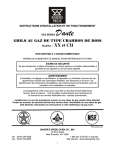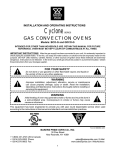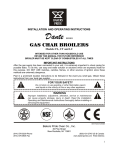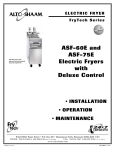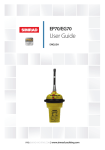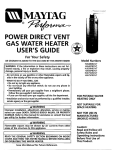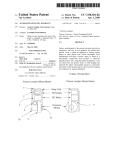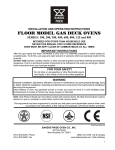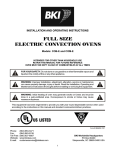Download Bakers Pride BCO-G Operating instructions
Transcript
BAKERS PRIDE INSTALLATION AND OPERATING INSTRUCTIONS Cyclone SERIES GAS CONVECTION OVENS Models: BCO-G and GDCO-G INTENDED FOR OTHER THAN HOUSEHOLD USE. RETAIN THIS MANUAL FOR FUTURE REFERENCE. OVEN MUST BE KEPT CLEAR OF COMBUSTIBLES AT ALL TIMES. After the gas supply has been connected to your unit, it is extremely important to check piping for possible leaks. To do this, use soap and water solution or solutions that are expressly made for this purpose. DO NOT USE matches, candles, flames, or other sources of ignition since these methods are extremely dangerous. Instructions to be followed in the event you smell gas should be posted in a prominent location. Obtain these instructionsfrom your local gas supplier. IMPORTANT INSTRUCTIONS: ! ! FOR YOUR SAFETY Do not store or use gasoline or other flammable vapors and liquids in the vicinity of this or any other appliance. WARNING Improper installation, adjustment, alteration, service or maintenance can cause property damage, injury or death. Read the Installation, Operating and Maintenance Instructions thoroughly before installing or ! ! servicing this equipment. ! WARNING Initial heating of oven may generate smoke or fumes and must be done in a well-ventilated area. Overexposure to smoke or fumes may cause nausea or dizziness. ! This equipment has been engineered to provide you with year round dependable service when used according to the instructions in this manual and standard commercial kitchen practices. 8/03 Form # 8898500 REV B BAKERS PRIDE OVEN CO., INC. (914) 576-0200 Phone (914) 576-0605 Fax 30 Pine Street New Rochelle, NY 10801 1 (800) 431-2745 US & Canada www.bakerspride.com Table of Contents I. INSTALLATION INSTRUCTIONS SECTION A B C D E F G H I J ITEM PAGE Receiving Set Up / Mounting Installation with Casters (Optional) Location and Minimum Clearances Gas Connections Electrical Connection Flue Connection Ventilation Burner Operation System Check Rotary Control Programming Menus 2 3 4 4 4 5 5 6 6 6 II. OPERATING INSTRUCTIONS A B C D General Instructions Operation Sequence Rotary Control Cook only rotary control Timed cooking rotary control Cook and hold- rotary control Optional steam injection rotary control To cool down the oven quickly Cleaning Servicing Wiring Diagrams Warranty International Distribution & Service Centers 7 7 7 7 7 8 8 8 8 9, 10 11 12 I. INSTALLATION INSTRUCTIONS A. RECEIVING Read the notice on the outside carton regarding damage in transit. Damage discovered after opening the carton is CONCEALED DAMAGE. Carrier must be notified immediately to send an inspector and to furnish forms for claims against the carrier. When the oven arrives, it should consist of: Acrate or carton containing your new oven (two for a stacked unit). A carton containing four 31 legs with mounting hardware (set of four 6 legs is supplied for stacked installations). A carton containing a Flue Adapter and a Draft Hood. Optional: for Direct Venting (Not available for European Community Countries). 2 B. SET UP / MOUNTING: NOTE: This appliance must be installed by competent personnel in accordance with the rules in force. In the U.K., Corgi registered installers (including the regions of British Gas) undertake to work to safe and satisfactory standards. This appliance must be installed in accordance with the current Gas Safety (Installation and Use) Regulations and the relevant Building Regulations/IEE Regulations. Detailed recommendations are contained in the British Standard Codes of Practice B.S. 6172, B.S. 5440: Part 2 and B.S. 6891. Your oven will be packed sitting on its bottom. The skid may be left under the oven for convenience in further handling. Unpack carefully, avoiding damage to the Stainless Steel front and/or trim. If concealed damage is found, follow the instructions detailed in Section A (Receiving). Keep the area around the ovens free and clear of combustible materials. Do not store any materials on top of or under any oven. The provision for adequate air supply to your oven for ventilation and proper gas combustion is essential. As a minimum, observe the clearances detailed in Section D (Location). Provide adequate ventilation and make up air in accordance with local codes. Servicing your oven is done through the front control panel and right side access cover. Ensure that these areas are kept unobstructed for easy access. For a single unit: (1) Tilt Oven over to left-hand side and attach two 31 legs on the right-hand side with three ½ bolts and washers. Tighten firmly. (2) Using proper lifting equipment, lift up the left-hand side and attach two 31 legs on the left-hand side the same way. For a stack of two ovens: (1) Remove flue from bottom oven prior to stacking. When top oven is properly positioned on bottom oven, re-install the flue back on the bottom oven. (2) Tilt lower unit over to the left-hand side and position two 6 legs on the right side (one for front and one for back), secure in place by using 4 bolts (3/8-16) per leg. Tighten firmly. (3) Using proper lifting equipment, lift up the left side of the unit and attach the other two legs in the same way. (4) Using the lifting equipment, raise the top oven to proper height and slide on top of the bottom oven. Line up sides and front and fasten to each other at the rear of the units by using a mounting bracket supplied in the stacking kit. To assemble an open rack stand: Refer to Figure 1 (1) Loosen 12 bolts (attaching 31 legs) slightly. (2) Remove 4 inner bolts, 1 from each of the 4 legs, place top right angle and top left angle underneath and tighten these 4 bolts. (3) Insert Open Rack Shelf and tighten into place with eight 3/8-16 screws, washers and nuts. (4) Position Rack Supports and tighten in place using 4 each of flat washers and 5/16-18 Hex Nuts. Open Rack Stand Figure 1 31 Legs Top Left Angle Top Right Angle 1/2 Flat Washer (4 corners only) 3/8-16 x 3/4 large Truss Head Screw w/Nut & Washer (8) 1/2-13 x 1 Large Hex Head Bolt (12) 5/16 Flat Washer (4) Open Rack Shelf 5/16-18 Hex Nut (4) Rack Support 3 ! CAUTION: DO NOT STORE COMBUSTIBLE ITEMS OR MATERIALS ON RACKS. Fit the Standard Flue Diverter supplied into the hole in the top of the oven for under ventilation hood installation and secure with screws. For direct venting, FlueAdapter and Draft Hood must be placed into the hole on top of the oven. C. INSTALLATION WITH CASTERS (OPTIONAL): Four casters (two with wheel brakes) and the mounting hardware are packed and included in the shipment if ordered. Install casters with wheel brakes on the front of the unit. Installation of the unit should be made with a connector that complies with the latest edition of the Standard for Connectors for Movable Gas AppliancesANSI Z21.69 in the USA (CAN CSA-6.16 in Canada) and a quick-disconnect device that complies with the latest edition of the standard for quick disconnect devices for use with gas fuel ANSI Z21.41 in the USA (CSA 6.9 in Canada). Adequate means must be provided to limit the movement of the appliance without depending on the connector and any quick disconnect device or its associated piping to limit appliance movement. The restraint should be attached to the rear legs of the oven on which casters are mounted. If disconnect of the restraint is necessary, the restraint should be immediately reconnected after the appliance has been returned to its originally installed position. D. LOCATION AND MINIMUM CLEARANCES: Move the oven to its final location keeping the minimum clearance from the back of the oven to the wall. This clearance is necessary for safe operation and to provide proper air flow to the burner chamber. ! SUITABLE FOR INSTALLATION ON COMBUSTIBLE FLOOR WHEN INSTALLED WITH LEGS OR CASTERS PROVIDED. ! ! CAUTION: DO NOT SET THE OVEN WITH ITS BACK FLAT AGAINST THE WALL. IT WILL NOT OPERATE PROPERLY UNLESS THERE IS AT LEAST THREE INCHES BREATHING SPACE BEHIND THE OVEN ! E. GAS CONNECTION: The ovens should not be installed on the same gas supply line with space heaters, boilers or other gas equipment with high intermittent demand. The installation of the oven must conform to the latest local codes or National Fuel Gas Code, ANSI Z223.1, Natural Gas Installation Code, CAN/CGA-B149.1, or the Propane Installation Code, CAN/CGA-B149.2. The appliance must be isolated from the gas supply piping system by closing its manual shut-off valve during any pressure testing of the gas supply piping system at test pressures equal to or less than ½ psig (3.45kpa). The appliance and its shut-off valve must be disconnected from the gas supply piping system during any pressure testing of that system at test pressures in excess of ½ psig (3.45kpa). Use a pipe joint compound that is resistant to the action of liquefied petroleum gases when making gas connections. For Propane gas, use at least ½ (13 mm) pipe or tubing with a 5/8 (16 mm) inside diameter. For Natural gas, use ¾ (19 mm) pipe. 4 The gas pressure regulator is part of the combination valve and is adjusted to yield a pressure of 3.5 water column (9 mbar) for Natural Gas. If the oven is ordered for use on Propane Gas or Butane, the pressure regulator in the combination valve is preset at the factory to yield a pressure of 10 water column (25 mbar). NOTE: No external regulator is required. Gas supply pressure in the European Community countries should be as below. Gas Type Supply Pressure G20 G25 G20/25 G30 G31 20 mbar 25 mbar 20/25 mbar 30 or 50 mbar depending on country 30, 37, or 50 mbar depending on country A separate shut-off valve for each oven must be provided. It should be as close as possible to the place where the gas line goes into the oven. It must be located such that it is easily accessible. When stacking with another oven, two shut-off valves, one for each of the two ovens, must be provided. After the Gas Supply has been connected, it is extremely important to check all the piping for leaks. Use a soap and water solution or a product expressly made for this purpose. Do not use matches, candles or a flame and so forth to check leaks since these methods are extremely dangerous. F. ELECTRICAL CONNECTION: The oven, when installed, must be electrically grounded in accordance with local codes and/or the latest edition of the National Electrical Code ANSI/NFPA No. 70 in the USA (Canadian Electrical Code CSAStandard C22.1, Part 1 in Canada). In Europe, the appliance must be connected by an earthen cable to all other units in the complete installation and, thence, to an independent earth connection in compliance with EN 60335-1 and/or local codes. The electric motor, all the related switches, interior lights, and the timer/buzzer are all connected through the 6-foot (1829 mm) power supply cord located at the rear of the oven. The supply cord must be plugged into a properly grounded, three-prong receptacle. DO NOT CUT OR REMOVE THE GROUNDING PRONG FROM THE PLUG. Normal factory connections are made for 120 voltsA.C., 60 hz, Service in USAand Canada or 240 volts A.C., 50 hz service in European community countries. Other voltages can be supplied upon request. Electrical characteristics of this unit can be found on the rating plate located on the right side of the unit. This unit is provided with a permanently lubricated electric motor.Awiring diagram may be found on the back of the service panel on the right-hand side and in this manual. G. FLUE CONNECTION VENTILATION: Installation under ventilation hood (standard): If the oven is not vented directly and is installed under a ventilation hood, the unit is ready to be installed as is. Local inspectors and ventilation specialists should be consulted so that the design and the installation of the hood conform to local/municipal codes. In the U.K., follow ventilation requirements as detailed in B.S. 5440. 5 Optional direct venting (not available for European community countries): If direct venting, a flue adapter and a draft hood are required to be installed. They prevent the flue gases leaving the oven to be affected by the air pressure changes on the outside of the flue stack extending out of the building. The flue pipe from the draft hood must not run downwards at any point from the oven to the final outlet. It should always slant slightly upwards. For best results, is should rise straight up. The venting system shall be in accordance with the National Fuel Gas Code,ANSI Z223.1 / NFPA54 and or the CSA B149.1, Natural Gas and CSA B149.2, Propane Installation Codes, and local codes. NOTE: DO NOT PUT A DAMPER IN THE FLUE AND DO NOT CONNECT A BLOWER DIRECTLY TO THE FLUE. If the flue runs directly to the free air outside the building, use a wind deflector or a UL listed vent cap at the end of the pipe. Termination of the vent must be at least two feet above the highest part of the roof within ten feet. REF:AGACATALOG NO. XH0474. H. BURNER OPERATION: The oven burner flame should always have a blue appearance. This indicates a good mixture of air and gas. When using LP gas, the flame will have a blue-yellow appearance. There may be intermittent yellow-orange flame noticed. This is caused by dust particles burning in the flame. I. SYSTEM CHECK- ROTARY CONTROL: (1) Open the oven door. (2) Turn Selector Switch to HI. The indicator light near Selector Switch and oven light will illuminate. (3) Close the door. Oven lights will go off and fan will run. Make sure fan is rotating clockwise looking from front. (4) Press Oven Light switch. Oven light will go on and will go off when switch is released. (5) Turn Gas Cock Dial to ON position (only for USA and Canada). (6) Turn the thermostat knob. The indicator light near the thermostat will illuminate and the burners will come on. (7) Turn the Timer Knob and set a time of 2 minutes. At the end of 2 minutes, you should hear the buzzer. Turn the timer knob to 0, to stop the buzzer. (8) Open the oven doors. Oven lights will go on and burners and fan will go off. (9) Turn Selector Switch to Cool Down position. The fan will run to cool down the oven. (10) Turn Selector Switch to 0 position. (11) Close the oven doors. NOTE: OVEN STARTS HEATING AS SOON AS THE SET TEMPERATURE IS HIGHER THAN THE OVEN TEMPERATURE WITH THE OVEN DOORS CLOSED AND THE SELECTOR SWITCH NOT IN “0” POSITION. THERMOSTAT INDICATOR LIGHT GOES OUT WHEN OVEN REACHES SET TEMPERATURE AND COMES ON WHEN OVEN IS HEATING UP. IN THE EVENT OF POWER FAILURE, THE OVEN WILL NOT OPERATE. RESTORATION OF POWER AFTER ANY DURATION, WILL RETURN UNIT TO NORMAL OPERATION. J. PROGRAMMING MENUS (for units with digital controls): Refer to C&H - 3 Plus Controller Operating/ProgrammingInstructions Manual. 6 II. OPERATING INSTRUCTIONS A. GENERAL INSTRUCTIONS: (1) This equipment has an Electronic Temperature Control and Electronic Hot Surface Direct Ignition System. (2) Due to increased efficiency of this oven, the temperature of standard recipes may be reduced 50°F (30°C). (3) Always load each shelf evenly. Space pans away from each other and from sides and back of oven to allow maximum air flow between them. (4) Large tempered glass windows and interior lights allow a close check on the product, making it unnecessary to frequently open the doors. Products cook faster in a convection oven as compared to a conventional oven. Depending on the product and the type of pans used, time saving may run from 20 percent to as high as 50 percent. B. OPERATION SEQUENCE ROTARY CONTROL: Cook only rotary control: (1) Close the oven doors. (2) Turn Selector Switch to HI or LO position. The indicator light near the Selector Switch will be illuminated. (3) Turn the thermostat knob to the desired cooking temperature. (4) Upon reaching the set temperature, the indicator light near the thermostat will go out. (5) Load the oven with product to be cooked. (6) Remove the product from the oven when done. Timed cooking rotary control: (1) Close the oven doors. (2) Turn Selector Switch to HI or LO position. The indicator light near the Selector Switch will be illuminated. (3) Turn the thermostat knob to the desired cooking temperature. (4) Upon reaching the set temperature, the indicator light near the thermostat will go out. (5) Load the oven with product to be cooked. (6) Turn the timer knob to the desired bake time and timer will start counting down. (7) When timer reaches zero, a buzzer will sound. (8) Turn the timer knob to O position. (9) Remove the product from the oven. NOTE: TIMER IS A SIGNAL DEVICE ONLY AND DOES NOT CONTROL THE OVEN. Cook and Hold Rotary Control: (1) Close the oven doors. (2) Turn Selector Switch to HI or LO position. The indicator light near the Selector Switch will be illuminated. (3) Turn the thermostat knob to the desired cooking temperature. (4) Upon reaching the set temperature, the indicator light near the thermostat will go out. (5) Load the oven with product to be cooked. (6) Turn the timer knob to the desired bake time and timer will start counting down. (7) When timer reaches zero, a buzzer will sound. (8) Turn the Timer knob to O position. (9) Turn the thermostat knob to the desired hold temperature. (10) Remove the product from the oven when needed. 7 Optional steam injection: Rotary control: The solenoid valve for steam injection is mounted behind the service panel on the right-hand side of the unit. The electronic timer is preset at the factory. A ¼ copper tubing is provided on the Solenoid Valve for water hookup with a compression fitting.After the water hookup is made, make sure that there are no leaks. For steam injection, press the Steam switch momentarily. NOTE: DO NOT USE STEAM INJECTION AT TEMPERATURES BELOW 275°F (135°C). Oven cool down Rotary control: To cool down the oven to a lower desired temperature, follow the steps detailed below. (1) Open the oven doors. (2) Turn Selector Switch to oven cool down position. Fan will now operate and cool down the oven. (3) When the oven has cooled down to the desired temperature, turn the Selector Switch to O position. Close oven doors. C. CLEANING: CLEAN ONLY WHEN OVEN IS COLD (1) With porcelain enamel interiors, this oven is designed to be as maintenance free as possible. However, for best results, the oven should be cleaned regularly. Enameled interiors can be easily cleaned with oven cleaners. KEEP CLEANING FLUIDS AWAY FROM ELECTRICAL WIRES, LIGHT SOCKETS, SWITCHES AND CONTROL PANEL. (2) Baked on splatter, oil, grease or discoloration on the stainless steel front or inside of the oven may be removed with the stainless steel cleaner supplied or any other similar cleaning agent. NOTE: ALWAYS RUB THE STAINLESS STEEL ALONG THE GRAINS. (3) To clean the blower wheel, remove and immerse in ammoniated water for 20 to 25 minutes. Then, scrub it off with a small, stiff brush. The same procedure can be followed for wire racks and rack supports. To remove the blower wheel, loosen the set screws (2) on the hub of the blower wheel and tighten the 3/8 wheel puller bolt (supplied) in center of the hub (See Figure 2). D. SERVICING: NOTE: THIS APPLIANCE MUST BE SERVICED BY AN AUTHORIZED SERVICE AGENT. Figure 2 Cleaning The Blower Wheel Blower Wheel (1) Power supply to the unit must be disconnected before any service is performed. (2) Most of the service on the unit can be performed from the front and/or control Set Screws (2) panel side. (3) For proper servicing, access to the control panel side of the unit will be required. (4) It will be necessary to have access to the back of the oven for service needs related to the gas supply and electric power supply. (5) A system wiring diagram is provided in this manual and on the back of the service panel on the right side of the oven. (6) This unit is provided with a permanently lubricated electric motor. Wheel Puller Bolt 3/8-Hex (7) All servicing should be performed by a factory-authorized technician only. (8) For proper maintenance and repairs, call the factory toll free (800-431-2745) for an authorized service agency in your area. Motor NOTE: THE VENTILATION SYSTEM MUST BE INSPECTED AT LEAST EVERY SIX MONTHS AND MAINTAINED CLEAN AND FREE OF OBSTRUCTIONS. 8 SINGLE-PHASE 120V WIRING DIAGRAM (PUSH-BUTTON CONTROL) 24 VAC 25 30 7 6 8 5 1 4 2 3 27 GREEN LIGHT 30 10 LOW 26 TIME DELAY RELAY 24 HIGH 29 BLACK WHITE 120V BUTT SPLICE 27 28 TRANSFORMER GROUND 4 POSTION SWITCH 9 YELLOW 20 24V BLUE P1 P2 P3 P4 42 34 41 15 21 GROUND STUD 15 RELAY 13 LIGHTS 44 36 35 38 37 T10 T11 33 IGNITION CONTROL DOOR SWITCH 32 PROBE T13 T12 CH104 CONTROL 17 16 GROUND STUD 6 8 PUSH BUTTON SWITCH S2 19 W 17 13 20 21 9 34 10 41 5 4 7 43 5 24 18 31 23 COMBINATION VALVE 12 14 42 12 2 2 POWER SWITCH 32 GROUND STUD 23 3 11 DOOR SWITCH IGNITER 31 1 40 11 COM 22 44 8 4 1 33 16 FAN MOTOR 14 GND T2 T3 T4 T5 120V L1 MV1 T7 T9 T8 40 18 MOT 25 T6 T1 S1 29 26 39 PROBE 3 CENTRIFUGAL SWITCH 19 FLAME SENSOR SINGLE-PHASE 120V WIRING DIAGRAM (DIAL CONTROL) HIGH 29 10 27 POWER LIGHT TIME DELAY RELAY 25 30 8 4 POS SWITCH 24 28 7 6 8 5 1 4 2 3 LOW 26 BLACK 120V WHITE BUTT SPLICE 9 P1P2P3P4 TRANSFORMER GROUND 32 T-STAT LIGHT 13 YELLOW BLUE CENTRIFUGAL SWITCH FAN MOTOR 24V PROBE IGNITION CONTROL T-STAT L1 S2 T6 T7 4 14 LIGHTS 6 36 7 3 4 4 34 NO 6 31 39 14 38 37 18 3 23 IGNITER 19 3 1 7 1 12 11 2 33 FLAME SENSOR 33 22 32 DOOR SWITCH 9 24 10 15 22 COMBINATION VALVE 5 2 NC MOT 29 COM GROUND STUD BUZZER 2 COM 20 21 1 POWER SWITCH MV1 12 15 60 MIN TIMER 17 GND 13 LIGHT SWITCH 26 GROUND STUD 19 W 25 16 16 20 11 T8 T9 T10T11 17 35 18 S1 21 23 GROUND STUD 31 BAKERS PRIDE BAKERS PRIDE LIMITED WARRANTY 30 Pine Street New Rochelle, NY 10801 1-800-431-2745 914-576-0200 fax 914-576-0605 4/02 11 INTERNATIONAL DISTRIBUTION AND SERVICE CENTERS BAKERS PRIDE BAKERS PRIDE INTERNATIONAL 30 Pine Street New Rochelle, NY 10801 USA +1 (914) 576-0200 +1 (914) 576-0605 fax [email protected] www.bakerspride.com RUSSIA Perfi, Ltd. — Dmitri Slavin 22 Marksistskaya Street Moscow, Russia 109147 +7 (095) 912 4100 +7 (095) 913 3553 fax [email protected] 729 Third Avenue Dallas, TX 75226 USA +1 (214) 421-7366 +1 (214) 565-0976 fax [email protected] NETHERLANDS CANADA Wisselaar Fast Food & Systeemgastronomie B.V. — Jankees Rovers Nijverheidsweg 41 3341 LJ, Hendrik Ido Ambacht The Netherlands +31 (78) 683 3833 +31 (78) 683-3830 fax www.wisselaar.nl Rabco — Steve Vella 4500 Sheppard Avenue E. Unit 9-11 Scarborough Ontario Canada MIS 3R6 +1 (416) 321-5823 +1 (416) 321-5826 fax [email protected] GERMANY UNITED KINGDOM / IRELAND FEM Food Equipment Mktg — Horst Herbert Fuchshaldeweg 37 D-77654 Offenburg, Germany +49 (781) 32077 +49 (781) 42365 fax [email protected] www.femgmbh.com BAKERS PRIDE Europe — Tim White Wealden Est Farningham Rd Crowborough, E. Sussex, TN6 2JR United Kingdom +44 (1892) 667 311 +44 (1892) 667 322 fax [email protected] ASIA / AFRICA/ ME / CARIBBEAN / MEXICO / LATIN AMERICA GREECE Heinami S. A. — Thanos Georgacopoulos 87 Alimou Avenue 17455 Alimos, Greece +30 (210) 99 66 040 +30 (210) 99 66 047 fax [email protected] www.heinami.gr Dorian Drake International 2 Gannett Drive White Plains, NY 10604 USA +1 (914) 697-9800 +1 (914) 697-9190 fax [email protected] www.doriandrake.com JAPAN DENMARK Niwa Shoji Kaisha - Proserv — Akio Matsunaga 3-4-26, Tsukamoto Yodogawa-ku, Osaka, 532-0026 Japan +81 (6) 6307 7471 +81 (6) 6307 9181 fax [email protected] FiBeMa Catering Udstyr Aps. Kodboderne 18, Kodbyen 1714 Copenhagen, Denmark +45 (33) 21 33 70 +45 (31) 21 10 30 fax [email protected] www.fibema.dk FRANCE SCAL — Jacques Merran 20 Ave de la Baltique Za Courtaboeuf 1 Courtaboeuf Cedex 91958 France +33 (1) 6982 8585 +33 (1) 6982 8599 fax www.scal.fr NORWAY Einar Riise & Son — Svein Riise Enebakkveien 64C Oslo 6, Norway +47 (2) 208 3300 +47 (2) 219 0317 fax [email protected] www.riise.no BAKERS PRIDE OVEN CO., INC. (914) 576-0200 Phone (914) 576-0605 Fax 30 Pine Street New Rochelle, NY 10801 12 (800) 431-2745 US & Canada www.bakerspride.com Web Address













